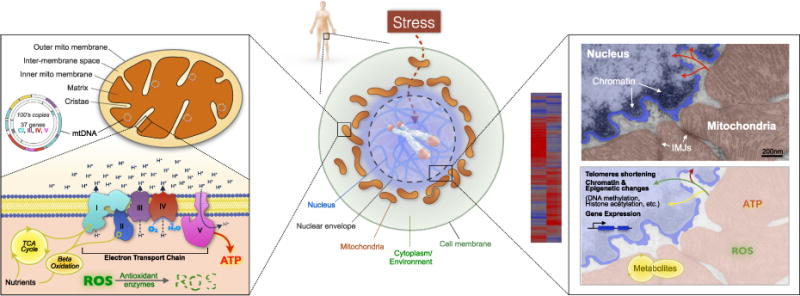FIGURE 1.

Mitochondrial structures, functions, and their positioning within the cell. (Center) Psychosomatic medicine research aims to understand how psychosocial and behavioral exposures including stress influence biological and physiological processes across the organism, including those inside the cell nucleus where genes are transcriptionally and epigenetically regulated. Mitochondria are positioned in the cell cytoplasm at the interface between psychosocial and behavioral factors and the cell nucleus. (Left) Detailed cartoon of mitochondrial structures, including the electron transport chain (respiratory chain) illustrating the flow of energy from nutrients to the pumping of protons (H+) to generate membrane potential, in part used to synthesize ATP, the energy currency of the cell. This process generates ROS, which are detoxified by specific mitochondrial antioxidant enzymes. (Right) Magnification of the mito-nuclear interface in a pseudo-colored electron micrograph showing the physical proximity between the chromatin in the nucleus and mitochondria (22). Mitochondria also communicate with each other via IMJs, nanotunnels, and other mechanisms (23). Signals derived from mitochondrial metabolism interact with other biochemical factors to coordinate gene expression and telomere maintenance via transcriptional and epigenetic mechanisms (24–26). ROS = reactive oxygen species; IMJs = intermitochondrial junctions; mtDNA = mitochondrial DNA; TCA = tricarboxylic acid; ATP = adenosine triphosphate. Color image is available only in online version (www.psychosomaticmedicine.org).
